
Stuttgart is the capital and largest city of the German state of Baden-Württemberg. It is located on the Neckar river in a fertile valley known as the Stuttgarter Kessel and lies an hour from the Swabian Jura and the Black Forest. Stuttgart has a population of 632,865 as of 2022, making it the sixth largest city in Germany, while over 2.8 million people live in the city's administrative region and nearly 5.5 million people in its metropolitan area, making it the fourth largest metropolitan area in Germany. The city and metropolitan area are consistently ranked among the top 4 European metropolitan areas by GDP; Mercer listed Stuttgart as 21st on its 2015 list of cities by quality of living; innovation agency 2thinknow ranked the city 24th globally out of 442 cities in its Innovation Cities Index; and the Globalization and World Cities Research Network ranked the city as a Beta-status global city in their 2020 survey. Stuttgart was one of the host cities for the official tournaments of the 1974 and 2006 FIFA World Cups.

Mühlacker is a town in the eastern part of the Enz district of Baden-Württemberg, Germany. Mühlacker station has direct rail connections with Stuttgart, Karlsruhe, Heidelberg, Pforzheim and the Northern Black Forest.
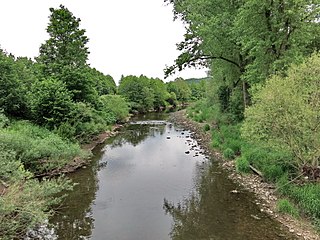
The Enz is a river flowing north from the Black Forest to the Neckar in Baden-Württemberg. It is 106 km long.
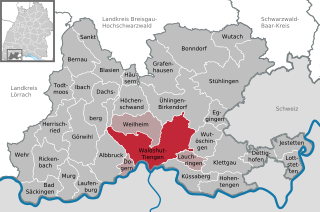
Waldshut-Tiengen, commonly known as Waldshut, is a city in southwestern Baden-Württemberg right at the Swiss border. It is the district seat and at the same time the biggest city in Waldshut district and a "middle centre" in the area of the "high centre" Lörrach/Weil am Rhein to whose middle area most towns and communities in Waldshut district belong. There are furthermore complexities arising from cross-border traffic between this area and the Swiss cantons of Aargau, Schaffhausen and Zürich. This classification relates to Walter Christaller's Central Place Theory, however, and not to any official administrative scheme.
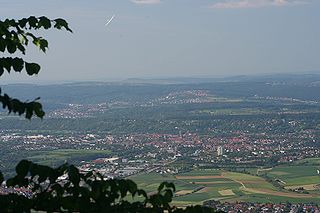
Kirchheim unter Teck is a town in Baden-Württemberg, Germany, in the district of Esslingen. It is located on the small river Lauter, a tributary of the Neckar. It is 10 km near the Teck castle, approximately 35 kilometres southeast of Stuttgart. It is the fourth city in the Esslingen district, forming a district centre for the surrounding communities.
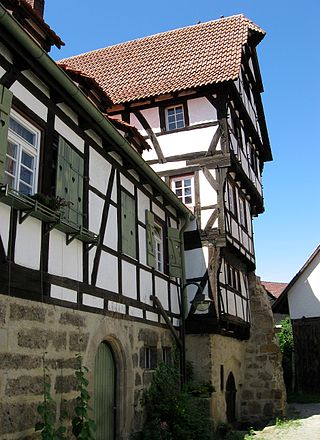
Aichtal is a town in the district of Esslingen in Baden-Württemberg in southern Germany. It is located 18 km south of Stuttgart. It belongs to the Stuttgart Region and the European Metropolitan Region Stuttgart. The municipality, which was created in 1975 as part of the municipal reform and consists of the three districts Grötzingen, Aich and Neuenhaus, has a population of around 10,000.

Neuenbürg is a town in the Enz district, in Baden-Württemberg, Germany. It is situated on the river Enz, 10 km southwest of Pforzheim.
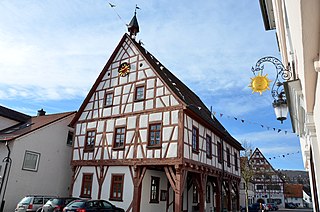
Schelklingen is a town in the district of Alb-Donau in Baden-Württemberg in Germany. It is situated 10 km north of Ehingen, and 20 km west of Ulm. Schelklingen and 82% of its territory form part of the Swabian Jura Biosphere Reserve.
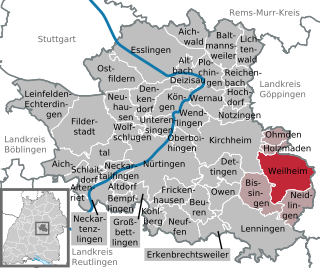
Weilheim an der Teck is a town in the district of Esslingen in Baden-Württemberg in southern Germany. It is situated 7 km southeast of Kirchheim unter Teck, and 13 km southwest of Göppingen. Locals often refer to it as just "Weilheim", although there are in fact several "Weilheims" in Germany including one other in Baden-Württemberg.

Sternenfels, consisting of the villages of Diefenbach and Sternenfels, is the most northern municipality in the Enzkreis (district) in Baden-Württemberg in Germany. The town is located at the border of the Kraichgau and Stromberg regions. Sternenfels is considered a showcase village and was mentioned in several national and European studies and competitions. It is about 20 km from Pforzheim and close to the UNESCO world heritage site of Maulbronn.

Deizisau is a town in the district of Esslingen in Baden-Württemberg in southern Germany. It belongs to the Stuttgart Region (until 1992 Region Mittlerer Neckar) and the Stuttgart Metropolitan Region. Deizisau is located between the towns of Plochingen and Esslingen am Neckar, about 20 kilometers southeast of Stuttgart, the capital of Baden-Württemberg. The river Neckar flows through this town.

The Western Railway in Württemberg was opened in 1853 and ran from Bietigheim-Bissingen to Bruchsal. It was the first railway link between the states of Württemberg and Baden in Germany and one of the oldest lines in Germany.

Bietigheim-Bissingen station is a junction station in the town of Bietigheim-Bissingen in the German state of Baden-Württemberg where the Württemberg Western Railway separates from the Franconia Railway. With its eight station tracks it is the largest station in the district of Ludwigsburg. It is also served by line S 5 of the Stuttgart S-Bahn.

Vaihingen (Enz) station is a long-distance and the regional station at an important railway junction in the town of Vaihingen an der Enz in the German state of Baden-Württemberg. It is classified by Deutsche Bahn as a category 3 station.

Mühlacker station is in the town of Mühlacker in the German state of Baden-Württemberg. It is at the junction of the Karlsruhe–Mühlacker line and the Western Railway. With its five platform tracks, it is the largest station in Enz district. It is served by InterCity, regional and Karlsruhe Stadtbahn services.
Riet is a village in the town of Vaihingen an der Enz, Germany. The population is around 900, and it is about 5 kilometres (3.1 mi) south of central Vaihingen.
Friedrich von Gerok was a German theologian.

The Heckengäu is a part of the Gäu, a region in the counties of Böblingen, Calw, Ludwigsburg and Enzkreis in the German state of Baden-Württemberg. Part of the landscape in the county of Calw is called Schlehengäu. Hence it is also called the Hecken- und Schlehengäu.
Karl Ludwig Friedrich von Roser (1787–1861) was a German entomologist who specialised in Diptera. His main career was as a high ranking government official and administrator in the Kingdom of Württemberg.
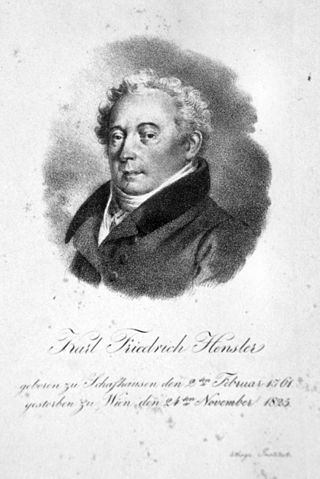
Karl Friedrich Hensler was a dramatist and theatre manager in Vienna.



























